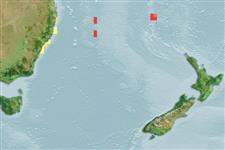Classificatie / Names
Lokale namen | Synoniemen | Catalog of Fishes(Genus, Soort(en)) | ITIS | CoL | WoRMS | Cloffa
>
Gobiiformes (Gobies) >
Gobiidae (Gobies) > Gobiinae
Etymology: Hetereleotris: Greek, heteros = other + The name of a Nile fish, eleotris (Ref. 45335); readerae: Named for Sally Reader, who helped collect the type series.
Eponymy: Sally E Reader is an ichthyologist at the Australian Museum Research Institute. [...] (Ref. 128868), visit book page.
More on authors: Hoese & Larson.
Environment: milieu / climate zone / depth range / distribution range
Ecologie
marien demersaal; diepte 6 - 11 m (Ref. 57078). Tropical
Southwest Pacific: eastern Australia.
Grootte / Gewicht / Leeftijd
Maturity: Lm ? range ? - ? cm
Max length : 2.4 cm SL mannelijk / geslacht onbekend; (Ref. 57078); 2.1 cm SL (female)
Korte beschrijving
Determinatiesleutels | Morfologie | Morfometrie
Dorsale stekels (totaal) : 7; Dorsale zachte stralen (totaal) : 8; Anale stekels: 1; Anale zachte stralen: 8. Diagnosis: Pelvic fins widely separated at base, rays I,5, fifth ray unbranched, distance between bases of inner rays of two fins about equal to base of either fin. Head pore 1 by each posterior nostril, a single anterior interorbital pore, a single posterior interorbital pore, a supraorbital pore behind eye, an infraorbital pore below supraorbital pore behind eye, a lateral canal pore behind infraorbital pore, a terminal lateral-canal pore over preopercular margin, and two preopercular pores. The first gill-arch is connected by membrane to inside of gill cover. The gill opening restricted to depth of pectoral base. Anterior nostril tubular; posterior nostril a simple pore or with slightly elevated anterior rim. In males, the first two dorsal spines prolonged or not. First dorsal fin without prominent black spots or dark lines, often with small brown irregular marks near the base of the fin. A black spot subequal to pupil diameter is found behind the eye. Second dorsal-fin rays I,8 (Ref. 57078).
Collected in rocky areas with some coral (Ref. 57078).
Levenscyclus en paargedrag
Maturiteit | Voortplanting | Paaien | Eieren | Fecunditeit | Larven
Hoese, D.F. and H.K. Larson, 2005. Description of two new species of Hetereleotris (Gobiidae) from the south Pacific, with a revised key to species and synonymization of the genus Pascua with Hetereleotris. Zootaxa 1096:1-16. (Ref. 57078)
Status op de Rode Lijst van het IUCN (Ref. 130435: Version 2024-2)
Gevaar voor de mens
Harmless
Gebruik door de mens
Tools
Speciale rapporten
Download XML
Internetbronnen
Estimates based on models
Preferred temperature (Ref.
123201): 20.9 - 22.3, mean 21.6 °C (based on 22 cells).
Fylogenetische diversiteitsindex (Ref.
82804): PD
50 = 0.5000 [Uniqueness, from 0.5 = low to 2.0 = high].
Bayesian length-weight: a=0.01023 (0.00477 - 0.02194), b=3.01 (2.83 - 3.19), in cm total length, based on LWR estimates for this (Sub)family-body shape (Ref.
93245).
Trofisch niveau (Ref.
69278): 3.1 ±0.3 se; based on size and trophs of closest relatives
Weerstandsvermogen (Ref.
120179): Hoog, minimale populatieverdubbelingstijd minder dan 15 maanden (Preliminary K or Fecundity.).
Fishing Vulnerability (Ref.
59153): Low vulnerability (10 of 100).
